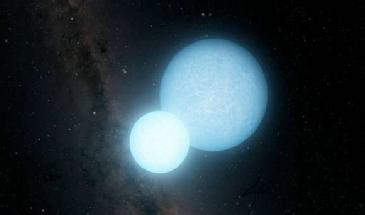PhD Opportunity in 2024
Investigating the origin of the lowest-mass white dwarf stars
Supervisor/Contact info: Dr Ingrid Pelisoli
Anticipated start date: October 2024
 White dwarf stars are the most common remnants of stellar evolution: over 95% of stars, including the Sun, will become white dwarfs after exhausting the fuel in their cores. How long this process takes depends on the initial mass of the star: massive stars evolve fast, whereas low mass stars burn their fuel more slowly and can take billions of years to turn into a white dwarf. Given the limited age of the Universe, only white dwarfs with masses higher than about half the mass of the Sun have had time to form through the evolution of a single star. However, there are hundreds of white dwarfs known to have much smaller masses. To explain their existence, a mechanism that results in enhanced mass-loss during evolution is required. What is this mechanism?
White dwarf stars are the most common remnants of stellar evolution: over 95% of stars, including the Sun, will become white dwarfs after exhausting the fuel in their cores. How long this process takes depends on the initial mass of the star: massive stars evolve fast, whereas low mass stars burn their fuel more slowly and can take billions of years to turn into a white dwarf. Given the limited age of the Universe, only white dwarfs with masses higher than about half the mass of the Sun have had time to form through the evolution of a single star. However, there are hundreds of white dwarfs known to have much smaller masses. To explain their existence, a mechanism that results in enhanced mass-loss during evolution is required. What is this mechanism?
Image credits: Caltech / IPAC
This project will investigate the formation channels that can result in low-mass white dwarfs through analysis of spectroscopic and photometric observations.
Binary interaction seems to play a very important role in the formation of low-mass white dwarfs. When two stars orbit close to each other, mass transfer can cause one or both stars to lose large amounts of mass. Are all low mass white dwarfs a result of binary evolution? Does the companion always survive the interaction, or can it be destroyed, leaving behind a single low-mass white dwarf?
The successful candidate will use spectroscopic and photometric observations from multiple sources to answer these questions by characterising a sample of low-mass white dwarfs in the solar neighbourhood. Photometric data to be used will include survey data from the Transiting Exoplanet Survey Satellite (TESS) and the Zwicky Transient Factory (ZTF), and from targeted observations with the high-speed photometers ULTRACAM and HiPERCAM. Spectroscopic data available for the sample includes observations with the Sloan Digital Sky Survey (SDSS), the Large Sky Area Multi-Object Fibre Spectroscopic Telescope (LAMOST), the Isaac Newton Telescope (INT), and the Southern Astrophysical Research Telescope.
